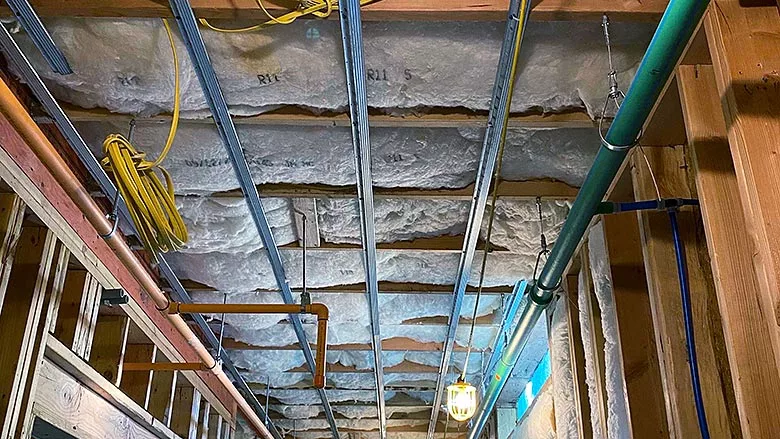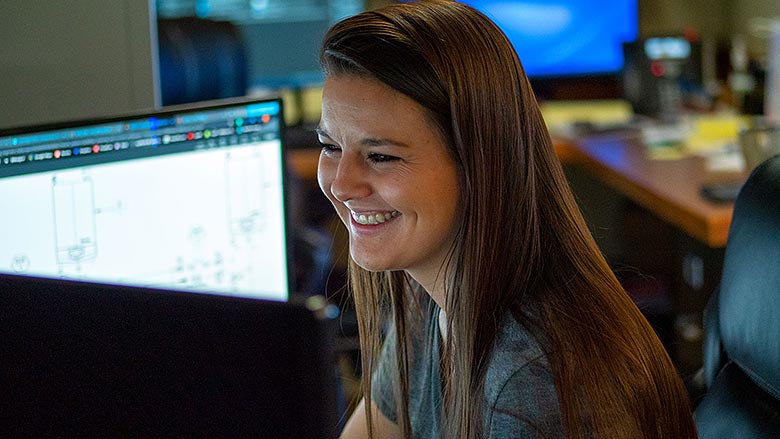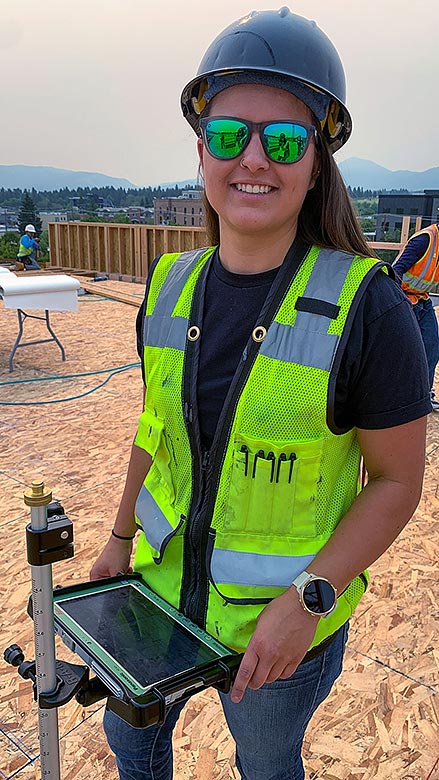Technology and talent lead the PHVAC industry into the future
Baylie Frost, VDC lead for Harvey’s Plumbing & Heating, represents the next generation of the plumbing industry.

Virtual design and construction is just one of the many new technologies transforming the construction industry.
“I don’t think people care that I’m young, or female. They care about what I know.”
Those words, spoken by Baylie Frost, a virtual design and construction (VDC) lead at Harvey’s Plumbing & Heating in Bozeman, Montana, must be music to the ears of an industry that is seeking to attract more talented young people to its ranks.
And in 26-year-old Frost, the industry has found a “natural” — someone who says she has always been fascinated by the design of homes and buildings.
“As a child, I was weirdly into looking into people’s houses,” Frost says. “Not to creep on them; I wasn’t interested in the people in the houses, just the setup of the houses themselves. So I thought, ‘OK, clearly I’m interested in building or creating houses.’”
Given that, it’s not surprising that she loves having the opportunity to work in VDC, one of the ever-growing lists of so many new technologies transforming the construction industry. For those who are unfamiliar with VDC, think of it as CAD on steroids.
“At the jobsite I use a Leica RTC360 laser scanner and a Total Station to gather information, then I bring that information back to the office where I stitch it together and create a point cloud,” Frost explains. “I load that into my computer along with the rough CAD piping drawings from the architects. The scans from the jobsite allow me to adjust the CAD drawings to real-world conditions. From there, I’m able to basically create a 100% accurate piping diagram. I can tell our plumbers exactly which pieces and fittings they’ll need.”
 The new face of the industry? Designing piping systems virtually can result in nearly 100% accuracy.
The new face of the industry? Designing piping systems virtually can result in nearly 100% accuracy.
A degree and a decision
Frost’s entry into the plumbing and HVAC industry began when she studied architecture for a semester at Montana State University. She quickly discovered it wasn’t what she was seeking; she was more interested in the construction side of the business. Then she learned that Gallatin College, an MSU affiliate, had a drafting program.
“I checked that out and realized it was exactly what I wanted to do,” she says. “For some of the classes, we would go to construction sites and follow projects from foundation to framing to finish work, and I thought that whole process was totally cool.”
In order to graduate from the two-year associate’s program at Gallatin College, Frost was required to get an internship. Someone suggested Harvey’s, but she hesitated.
“I thought, a plumbing and heating company? I’m a drafter, I don’t know what I’m going to be drawing there, that seems kind of dumb. So I almost didn’t apply.”
Ultimately — wanting to earn her degree and needing a job — Frost applied at Harvey’s. The interview went well, and they brought her on. That was in 2017, and she was promoted to VDC lead in 2019.
Frost notes that even in her brief time at Harvey’s she has experienced leaps in drafting technology.
“When I started, you’d get a CAD file, try to draw in plumbing systems, and turn those out as best you could,” she says. “Then we got our first scanners, and our minds were blown. It has continued to take off from there.”
Frost notes that companies who offer a comprehensive library of Revit files for their products, such as polypropylene pipe manufacturer Aquatherm, make it easier for her to design accurate systems in the era of VDC.
“We use fabrication parts out of Autodesk CAMduct ITM content, and it’s a big plus for Aquatherm that we can just pull in the Revit files and know they’ll all be dimensionally accurate,” she says. “In addition, Aquatherm is a lot easier to work with physically than metal pipe. It’s easier on our guys and easier to prefab and install. And it looks a lot nicer than steel or copper pipe.”
 As much as she appreciates the laser scanner, Baylie Frost enjoys using a Total Station on the jobsite because, “I like to feel a little more involved rather than just setting up the scanner and waiting for it to do its thing.”
As much as she appreciates the laser scanner, Baylie Frost enjoys using a Total Station on the jobsite because, “I like to feel a little more involved rather than just setting up the scanner and waiting for it to do its thing.”
Challenges and rewards
Like any job, being the VDC lead has its share of challenges. According to Frost, obtaining all the latest and most up-to-date information — such as equipment types, CAD files, spec sheets and so on — at the beginning of a project is always a challenge.
In addition, although she prides herself on making sure her plans are clear and accurate, she has to allow for the fact that a construction site can be an unpredictable place.
“For the installers, there’s a fine line between following my plans to a ‘T’ and dealing with unforeseen circumstances out in the field,” she says. “We may have scanned and planned everything accurately, but then maybe the electrical contractor came along and put a junction box in our way. It wasn’t there when we scanned, but it’s there now and we have to make sure our guys have what they need to offset around it.”
If jobsite unpredictability represents the downside of her job, Frost says the part of the job she enjoys the most is watching her drawings go from concepts to actual installed systems.
“Coordinating these systems is like solving a puzzle. You have all these different pieces and you keep trying to fit them into certain spots until everything gets organized and straightened out,” she says. “It’s very satisfying when you have everything fully coordinated and you give your drawings to the guys in the field, and everything goes well.”
Facing the unknown
Frost admits she didn’t know what to expect when she first entered the traditionally male-dominated PHVAC construction field. Not only was she new on the job, but she also obviously was young and female.
“Not knowing anything and being a girl in this field was pretty intimidating,” she says. “Most guys just aren’t used to girls being on jobsites, so at first you tend to get a lot of stares. Now that I’ve been doing this for a while, the guys have gotten used to me and they don’t think twice about it. And from my own perspective, I’ll admit that I kind of came into this with an image of the ‘typical construction worker,’ being some rude and crude guy who wouldn’t like working with a woman. I’m very happy to say that has absolutely not been the case.”
Frost makes it clear, however, that anyone and everyone entering the field must prove themselves.
“Just as I don’t think there should be any additional hurdles for women compared to men, I don’t think there should be any special considerations just because you’re female, either,” she explains. “If you want to be in this industry you have to work hard and make yourself valuable.”
Praise from a GC
Jonah Studer, a project engineer at Dick Anderson Construction in Bozeman, recently worked with Frost on the piping system for a new five-story, mixed-use building. He praises Frost for always being ahead of the game when it came to keeping his company informed and up-to-date throughout the project.
“Baylie was awesome,” Studer says. “She was always the first to reach out and let us know what their plan was as a subcontractor on our site — when they needed to be here and what their timeframe was to get their work done. As a general contractor, having the subs reach out in advance to let us know their schedules and their needs makes it a lot easier for us to accommodate them.”
Studer adds that he had absolutely no concerns when it came to working with Frost.
“Age, gender, race — to me it’s all irrelevant,” he says. “At the end of the day what matters is your knowledge and your willingness to constantly learn new things. The technology in our industry is advancing rapidly, and it doesn’t matter if you’re old, young, male, female, as long as you’re learning and picking up new things every day.”
Studer is also open-minded when it comes to new products. The mixed-use project he worked on with Frost, for example, was his first large-scale experience using Aquatherm polypropylene pipe.
“I haven’t dealt with Aquatherm too much, but it definitely went in smoothly on our project,” he says. “Being open to new products is all part of that willingness to embrace new technology and do new things, to understand that ‘that’s the way it has always been done,’ isn’t necessarily the best way to do something.”
‘Almost endless’ opportunities
Mitch Rausch, operations manager for Harvey’s Plumbing & Heating, says Frost’s work ethic, ability to find solutions to complex problems and willingness to learn are some of the qualities that have made her successful.
“Baylie started with us with a degree in Revit, but with no mechanical or plumbing industry experience,” Rausch says. “She listened, took direction, and expanded her knowledge of plumbing and mechanical code very quickly.”
Rausch adds that opportunities in the field of mechanical and plumbing design are almost endless. Although it is a relatively new career path, he says, it is growing exponentially and will soon be the norm for the whole construction industry.
“Whether as an engineer, system designer, or BIM and clash detection coordinator, the shortage of experienced field tradesmen makes it vital to replace their knowledge and expertise with virtual design and construction,” Rausch says. “For us at Harvey’s Plumbing & Heating, our only current cap on positions is our ability to find qualified individuals, not the number of positions we have to offer.
“There currently is a stigma that the trades are a lesser career path due to the manual labor aspect, and VDC/modeling is the way to fill/supplement these needed jobs in the construction industry,” he adds.
Frost agrees with Rausch’s assessment. “It seems like a lot of younger people don’t understand the opportunities available to them in the trades, which is unfortunate because the trades offer interesting, good-paying jobs,” she says.
A good word for the industry
Everyone knows the HVAC/P industry — along with many other trades — is facing a critical shortage of skilled labor, in part because the work is perceived as dirty and low-tech. Frost’s experience is not typically what young people think of when they think of “plumbing,” and she is not hesitant to share her eye-opening experiences in the PHVAC world with others. “I totally geek out about this stuff,” she says.
So, what would Frost tell a friend about choosing a career in the plumbing and mechanical field?
“It’s not easy. You definitely have to be passionate about it and put the time and effort in,” she says, “but if you’re a hard worker and you’re willing to learn, it’s really satisfying. As your knowledge grows so does your confidence. One of my favorite things is learning from each project: Taking all the information I learned from the previous job and applying it to the next one and making each project better and better.
“I tell everyone that I kind of accidentally fell into this job, and I didn’t realize I would enjoy it so much,” Frost adds. “But the more I got into it and started learning about mechanical systems and plumbing, it kept being really interesting. I wanted to know more, I wanted to see more, I wanted to learn more about how it’s actually done in the field. And then I begin to receive feedback from the field crews and that just pushed me to know and do even more.”
Photos courtesy of Harvey’s Plumbing & Heating.
Barry Campbell is vice president of marketing for Aquatherm.
Looking for a reprint of this article?
From high-res PDFs to custom plaques, order your copy today!





